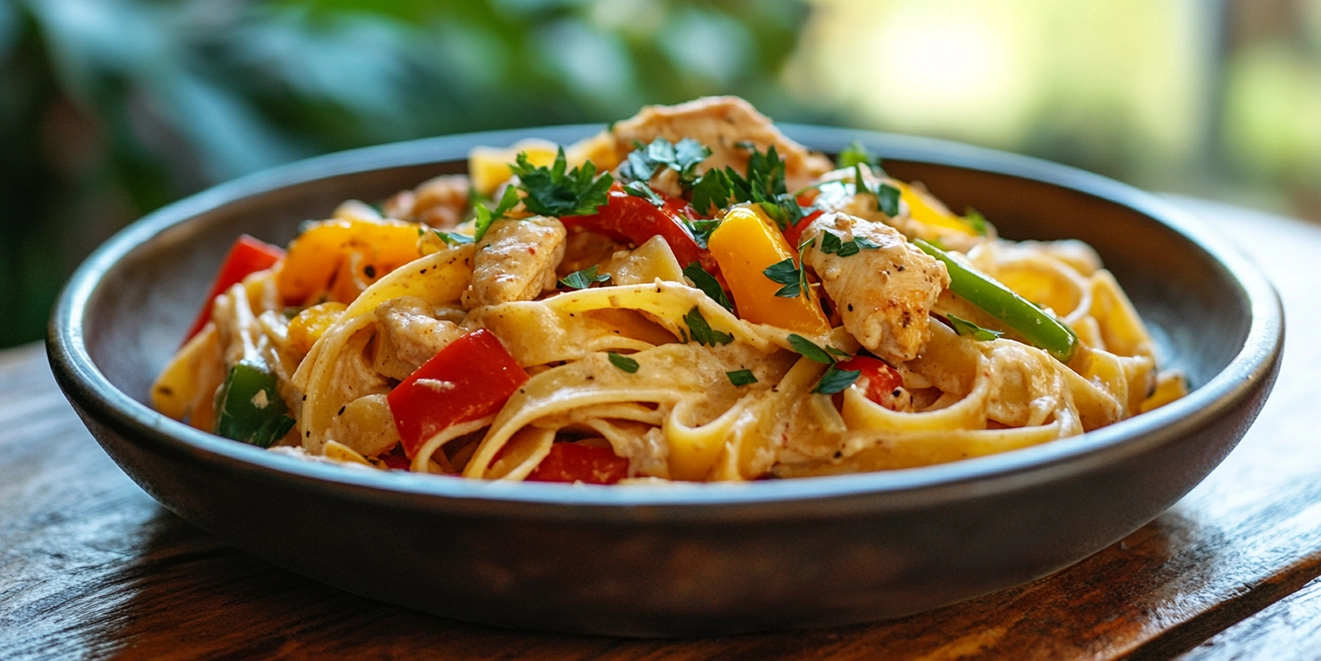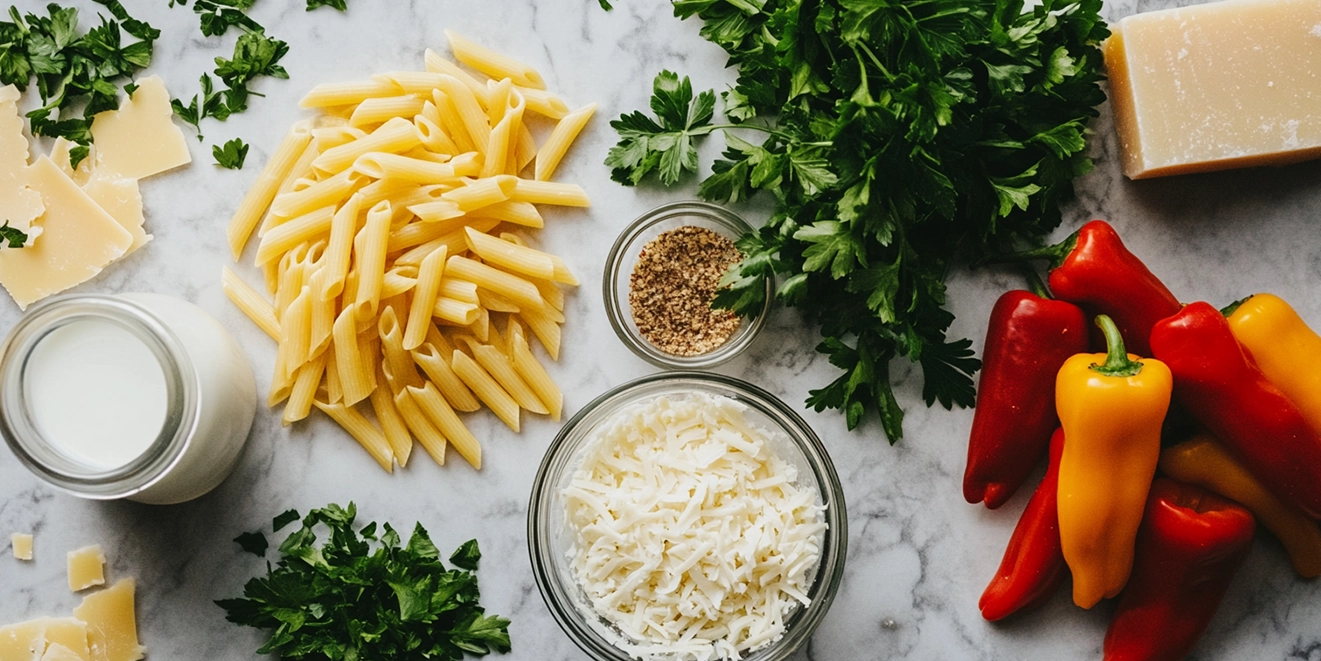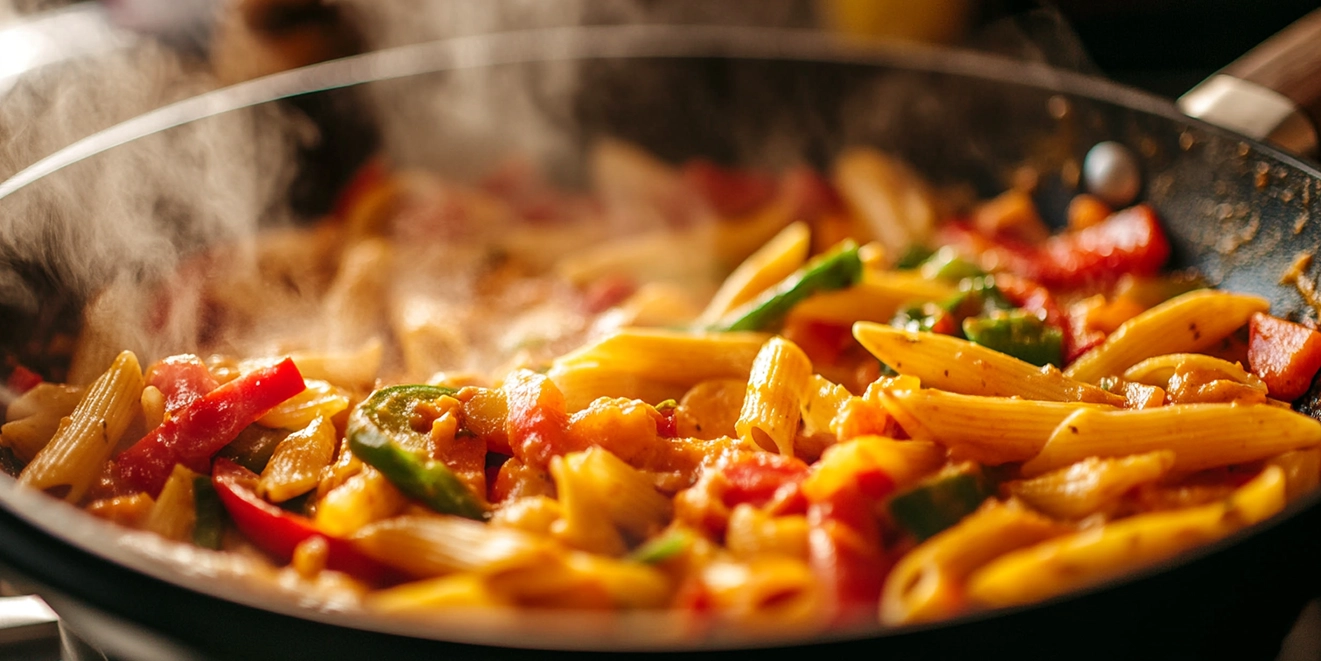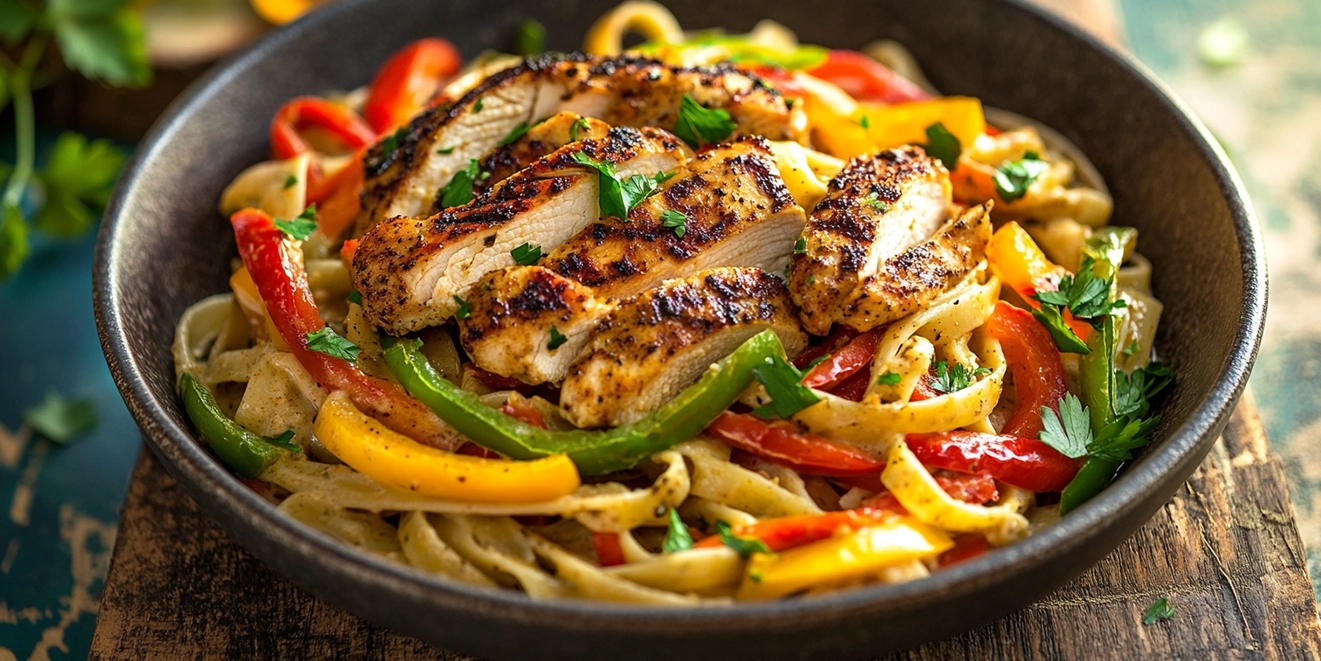
Table of Contents
Introduction to Rasta Pasta
The Origin and Cultural Background of Rasta Pasta
Rasta Pasta is a vibrant and flavorful dish that combines Caribbean and Italian culinary influences. The name “Rasta Pasta” is a nod to Rastafarian culture, which originated in Jamaica. The dish is believed to have been inspired by Caribbean cuisine’s colorful and bold flavors, paired with Italian pasta’s creamy, comforting texture.
Traditionally, Rastafarian diets emphasize natural, unprocessed ingredients and often lean toward vegetarian or vegan fare. However, Rasta Pasta has evolved to include a variety of proteins like jerk chicken, shrimp, or even tofu for those maintaining a plant-based diet. The signature feature of Rasta Pasta is its vibrant colors, reflecting the Rastafarian flag, which symbolizes faith, unity, and freedom. Bell peppers in red, yellow, and green are often used to achieve this visually striking presentation.
Its Growing Popularity in Modern Cuisine
Rasta Pasta has gained popularity far beyond its Caribbean roots in recent years. It has become a favorite in modern fusion cuisine, celebrated for its bold spices, creamy sauces, and versatile preparation. Chefs and home cooks appreciate its adaptability, as the dish can be customized with various proteins, vegetables, and heat levels to suit diverse tastes.
Social media platforms have also played a significant role in the rise of Rasta Pasta, with its vibrant colors and tantalizing presentation making it highly shareable. Whether featured on restaurant menus or prepared at home, Rasta Pasta continues to capture the hearts (and stomachs) of food enthusiasts worldwide, cementing its place as a modern culinary classic.
The Core Ingredients of Rasta Pasta
A Breakdown of the Essential Ingredients
Rasta Pasta is built on a harmonious blend of bold Caribbean spices and creamy Italian-inspired sauces. The core components include:
- Pasta – Typically penne, but other types like fettuccine, linguine, or rigatoni can also be used.
- Jerk Seasoning – The spice blend that gives the dish its distinctive flavor.
- Creamy Base – Either heavy cream or coconut milk, depending on the desired richness or dietary preferences.
- Fresh Vegetables – Primarily bell peppers, which add color and crunch.
- Protein – Options like jerk chicken, shrimp, or tofu to suit different dietary needs.
Highlighting Pasta Types Commonly Used
While penne pasta is the most popular choice due to its ability to hold the creamy sauce, other pasta shapes like rigatoni or rotini are equally effective for soaking up the flavorful jerk seasoning and sauce. Longer pasta types like fettuccine are less common but can create a more elegant presentation.

The Star Ingredient: Jerk Seasoning
What is Jerk Seasoning?
Jerk seasoning is a quintessential Caribbean spice mix rooted in Jamaican cuisine. It combines aromatic spices, herbs, and heat and is traditionally used for marinating and cooking meat.
Traditional Spices and Their Significance
Key ingredients of jerk seasoning include:
- Allspice: Known as “pimento” in Jamaica, this spice adds warmth and depth.
- Scotch Bonnet Peppers: Provide the signature fiery heat.
- Thyme: Adds an earthy, herbal note.
- Garlic, Ginger, and Onions: Enhance the flavor complexity.
- Brown Sugar: Balances the spiciness with a hint of sweetness.
How Jerk Seasoning Defines Rasta Pasta
Jerk seasoning transforms this dish into a Caribbean-Italian fusion masterpiece. It infuses the pasta and proteins with a bold, smoky flavor that sets Rasta Pasta apart from traditional creamy pasta dishes.
The Creamy Base
Heavy Cream or Coconut Milk: Traditional Versus Modern Approaches
- Heavy Cream: Often used in modern interpretations for a rich and decadent sauce.
- Coconut Milk: The traditional Caribbean approach offers a lighter, slightly sweet flavor that complements the jerk spices.
Creating the Perfect Creamy Sauce
To make a silky sauce:
- Sauté onions and garlic in olive oil or butter.
- Add heavy cream or coconut milk and simmer until thickened.
- Stir in Parmesan cheese (optional) and jerk seasoning for added richness.
Variations for Dairy-Free Options
For those avoiding dairy, use coconut or cashew cream to achieve the same creamy consistency while keeping the dish vegan-friendly.
Fresh Vegetables
The Role of Bell Peppers in Rasta Pasta
Bell peppers, especially red, yellow, and green, are key ingredients that bring vibrant color, crunch, and sweetness to the dish. They symbolize the Rastafarian flag and contribute to the visual appeal of Rasta Pasta.
Additional Vegetable Options for Added Flavor and Texture
- Onions: Add a caramelized sweetness.
- Scallions: Provide a fresh, green bite.
- Spinach or Kale: Incorporate greens for added nutrition.
- Zucchini or Mushrooms: Enhance the texture and flavor profile.
Protein Options
Classic Protein Choices: Chicken, Shrimp, and Tofu
- Jerk Chicken: The most traditional choice, marinated and grilled for smoky flavor.
- Shrimp: A quick-cooking and flavorful alternative.
- Tofu: Perfect for vegetarians, it absorbs the jerk marinade beautifully.
How to Marinate Proteins with Jerk Seasoning
- Combine jerk seasoning with olive oil, lime juice, and soy sauce.
- Coat the protein evenly and let it marinate for at least 30 minutes (or overnight for deeper flavor).
- Grill, bake or sauté the protein before adding it to the pasta.
Vegan and Vegetarian Alternatives
For plant-based variations, try:
- Tempeh: Marinated and pan-fried.
- Chickpeas: Roasted with jerk spices for a crunchy, flavorful topping.
- Plant-Based Meat Substitutes: Seasoned with jerk spices for an authentic taste.
The Cooking Process

Step-by-Step Guide to Making Rasta Pasta
Rasta Pasta is a straightforward dish that comes together beautifully with the right balance of flavor and technique. Here’s a detailed guide to creating this Caribbean-Italian fusion delight.
Preparing the Pasta
Selecting the Right Pasta
Penne is the most commonly used pasta for Rasta Pasta because its tubular shape holds the creamy sauce well. However, other options like rigatoni, rotini, or farfalle are excellent alternatives.
Tips for Cooking Pasta to Perfection
- Salt the Water: Add a generous amount of salt to the boiling water to enhance the pasta’s flavor.
- Cook al dente: Follow the package instructions, but reduce the cooking time by 1-2 minutes. This ensures the pasta remains firm and doesn’t become mushy when combined with the sauce.
- Reserve Pasta Water: Save a cup of the starchy cooking water to adjust the sauce’s consistency if needed.
Making the Sauce
Combining Ingredients for the Creamy Jerk Sauce
- Sauté the Base: Heat olive oil or butter in a large skillet and sauté chopped onions, garlic, and a pinch of thyme until fragrant.
- Add Cream or Coconut Milk: Pour in heavy cream or coconut milk, stirring to combine. Bring the mixture to a gentle simmer.
- Incorporate Jerk Seasoning: Stir in 2-3 teaspoons of jerk seasoning (or to taste), ensuring it blends evenly into the sauce.
- Thicken the Sauce: Allow the sauce to simmer until it thickens slightly, about 5-7 minutes. If desired, add grated Parmesan cheese for extra richness.
Adjusting Spice Levels to Taste
- Reduce the jerk seasoning or use a milder spice mix for a mild sauce.
- Add extra jerk seasoning or finely chopped Scotch bonnet peppers for more heat, adjusting gradually to avoid overpowering the dish.
Assembling the Dish
Mixing Pasta with Sauce and Vegetables
- Add the cooked pasta to the skillet with the sauce, tossing gently to coat the pasta evenly.
- Stir in the sautéed bell peppers (red, yellow, and green) and any additional vegetables you’ve prepared, ensuring they are evenly distributed.
- If the sauce is too thick, loosen the reserved pasta water.
Adding Protein and Garnishes
- Layer the cooked protein (jerk chicken, shrimp, tofu, etc.) over the pasta, mixing it in or leaving it on top for presentation.
- Garnish with freshly chopped parsley, scallions, or a sprinkle of grated Parmesan (optional).
- For added flair, drizzle a small amount of jerk marinade over the dish before serving.
Key Techniques to Enhance Flavor
- Marinate Proteins Thoroughly: Ensure proteins are well-seasoned with jerk spices for maximum flavor.
- Toast the Jerk Seasoning: Sauté the spices briefly in oil before adding liquids to release their aroma and depth.
- Balance the Sauce: If the jerk seasoning is too spicy, add a touch of honey or brown sugar.
Tips for Making Perfect Rasta Pasta
- Use coconut milk instead of heavy cream for a more authentic Caribbean twist.
- Pair your Rasta Pasta with a shrimp pasta recipe for an added seafood delight.
- Enhance the smoky flavor by trying the dish alongside a smoked brisket recipe.
Variations of Rasta Pasta

Rasta Pasta is a versatile dish that lends itself to endless creativity. Its adaptability allows for twists influenced by dietary preferences, regional ingredients, and fusion cuisine trends.
Vegan Rasta Pasta
Ingredient Substitutions for a Plant-Based Version
- Protein Alternatives: Use tofu, tempeh, or chickpeas marinated in jerk seasoning for a flavorful plant-based option.
- Dairy-Free Cream: Substitute heavy cream with coconut milk or cashew for the sauce. Both provide a creamy texture while keeping the dish vegan.
- Cheese Alternatives: Opt for plant-based cheese or nutritional yeast for added creaminess and a cheesy flavor.
Maintaining Authentic Flavors Without Animal Products
- Spices and Herbs: Stick to traditional jerk seasoning for authenticity.
- Coconut Milk: Enhances the Caribbean profile while keeping it rich and flavorful.
- Vegetables: To add texture and vibrancy, include a variety of colorful, fresh vegetables like bell peppers, zucchini, and spinach.
Gluten-Free Rasta Pasta
Using Gluten-Free Pasta Options
- Choose gluten-free pasta made from rice, corn, quinoa, or chickpeas. These options are widely available and work well with the creamy sauce.
- Cook gluten-free pasta slightly less than al dente to prevent it from becoming mushy when mixed with the sauce.
Adjusting Sauces and Seasonings for Dietary Restrictions
- Ensure jerk seasoning and any pre-packaged sauces are gluten-free by checking the labels.
- If necessary, use gluten-free flour or cornstarch as a thickener for the sauce.
Fusion Rasta Pasta
Creative Ways to Merge Rasta Pasta with Other Cuisines
- Rasta Pasta Pizza:
- Use a creamy jerk sauce as the pizza base.
- Top with jerk chicken, bell peppers, onions, and plant-based or traditional cheese.
- Bake until crispy and serve with a sprinkle of fresh parsley.
- Rasta Pasta Tacos:
- Use small tortillas as a base.
- Fill with Rasta Pasta (with or without protein) and garnish with fresh cilantro and lime juice for a Caribbean-Mexican twist.
- Rasta Pasta Stir-Fry:
- Swap traditional pasta for stir-fried rice noodles or even spiralized zucchini.
- Combine with jerk-marinated tofu or shrimp for a lighter, Asian-inspired version.
Examples of Fusion Ideas
- Rasta Pasta Sushi: Incorporate Rasta Pasta ingredients into sushi rolls, using bell peppers, jerk-marinated shrimp, and a creamy coconut drizzle.
- Rasta Mac and Cheese: Combine jerk seasoning with a cheesy béchamel sauce and bake with gluten-free breadcrumbs for a Caribbean twist on a classic comfort food.
Serving and Pairing Suggestions
Rasta Pasta is a bold and flavorful dish that shines independently but can be elevated with thoughtful accompaniments. The right sides, drinks, and desserts can complement the meal’s spicy, creamy, and colorful elements, creating a well-rounded dining experience.
What to Serve with Rasta Pasta
- A side of French bread makes an excellent companion.
- Try pairing it with squash casserole for a refreshing twist for a creamy side dish.
Ideal Side Dishes for Rasta Pasta
- Fried Plantains
- Sweet and caramelized fried plantains provide a delightful contrast to the savory, spicy flavors of Rasta Pasta.
- Jamaican Patties
- Serve flaky, spiced patties filled with beef, chicken, or vegetables as a starter or side.
- Rice and Peas
- A classic Caribbean staple, rice, and peas (cooked with coconut milk and beans) are a hearty and flavorful addition to the meal.
- Steamed Vegetables
- Lightly steamed broccoli, carrots, or green beans add freshness and balance to the richness of Rasta Pasta.
- Caribbean Coleslaw
- A tangy, slightly sweet coleslaw made with cabbage, carrots, and a lime-based dressing enhances the flavors while adding a refreshing crunch.
Drinks That Complement the Meal
- Tropical Cocktails
- Rum Punch: A classic Caribbean drink with rum, fruit juices, and grenadine.
- Pina Colada: Creamy and sweet, this coconut and pineapple-based cocktail pairs perfectly with the spiced pasta.
- Mocktails
- Mango or Passion Fruit Spritzer: Refreshing and fruity, these non-alcoholic drinks enhance the tropical vibe of the meal.
- Ginger Beer: The spicy kick of ginger beer complements the heat of the jerk seasoning.
Desserts That Pair Well with Rasta Pasta
- Coconut Rum Cake
- Moist and decadent, this dessert incorporates the signature Caribbean flavors of coconut and rum.
- Mango Sorbet
- Light and refreshing, mango sorbet helps cleanse the palate after the bold flavors of Rasta Pasta.
- Pineapple Upside-Down Cake
- It is a classic dessert with caramelized pineapple that adds sweetness and a tropical finish.
- Banana Fritters
- These crispy, lightly sweetened treats are a satisfying and easy-to-make dessert option.
- Tropical Fruit Salad
- A mix of fresh papaya, pineapple, mango, and kiwi is a simple yet delightful way to end the meal on a lighter note.
FAQs About Rasta Pasta
What makes Rasta Pasta unique?
Jerk seasoning and a creamy base sets Rasta Pasta apart, offering a balance of heat, spice, and creaminess. If you’re new to jerk seasoning, explore its versatility with this chicken taco recipe for a milder introduction.
Can I make Rasta Pasta vegan?
Absolutely! Swap the heavy cream for coconut milk and use a plant-based cheese alternative. For a hearty vegan option, pair it with this apple cobbler recipe for dessert.
What is Rasta Pasta sauce made of?
Rasta Pasta sauce is typically a creamy blend of Caribbean and Italian influences. The base is made with heavy cream or coconut milk and flavored with jerk seasoning for a spicy, smoky kick. Additional ingredients may include garlic, onions, Parmesan cheese, and a touch of lime juice to brighten the flavors. For those seeking a vegan option, coconut milk is often used instead of dairy-based cream, maintaining the dish’s rich and creamy texture.
Where did Rasta Pasta come from?
Rasta Pasta originated as a fusion dish inspired by Jamaican and Italian cuisines. The name reflects its connection to Rastafarian culture, a movement emphasizing unity, freedom, and a natural way of living. The dish incorporates vibrant colors from bell peppers (red, yellow, and green), which mirror the Rastafarian flag, and jerk seasoning, a hallmark of Jamaican culinary tradition. Over time, Rasta Pasta has become a global favorite, celebrated for its bold flavors and versatility.
What is pasta made of?
Traditional pasta is made from a combination of durum wheat semolina and water. Some varieties may include eggs for added richness and elasticity. Gluten-free pasta options from rice, corn, quinoa, or lentils are also widely available to cater to dietary needs. The shape and composition of the pasta often determine how well it pairs with different sauces, with penne being a popular choice for roasta pasta.
What did Guy eat at Rasta Pasta?
On an episode of Diners, Drive-Ins, and Dives, Guy Fieri visited a restaurant featuring Rasta Pasta. He enjoyed a flavorful dish with jerk chicken, vibrant bell peppers, and a creamy, spiced sauce served over perfectly cooked pasta. The bold, spicy flavors of the jerk seasoning and the creamy sauce won his praise, making Rasta Pasta a standout item on the show. His enthusiastic reaction contributed to the dish’s growing popularity across various culinary platforms.
Conclusion
Rasta Pasta is more than just a dish; it celebrates cultural fusion, vibrant flavors, and culinary creativity. Rooted in Jamaican heritage and blended with Italian influences, this bold and versatile meal has captured the hearts of food enthusiasts worldwide. This dish offers endless possibilities, whether savoring its creamy jerk sauce, experimenting with plant-based or gluten-free variations, or exploring creative fusions like Rasta Pasta tacos.
Perfect as a comforting main course or a show-stopping centerpiece for any gathering, Rasta Pasta embodies the spirit of innovation and tradition. By understanding its origins, ingredients, and cooking techniques, you can bring this colorful and flavorful masterpiece to your table and make it your own.
So, grab your favorite pasta, spice it up with jerk seasoning, and let the vibrant essence of Rasta Pasta transform your next meal into a culinary adventure!
